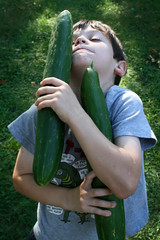
If you want to involve your children in growing vegetables, fruits and flowers this Spring, there are a few preparations you need make ahead of time. Make sure you spend some time on planning the garden design, selecting the plants that match their level of gardening experience, and determining how much effort will be needed. The time you spend with your child digging in the dirt will give you a great opportunity to establish a common goal, share a valuable experience, and reap the rewards of your effort. By starting a gardening project with you in the Spring and working regularly on it with you through the Summer, kids will learn a practical side of the old saying,”You reap what you sow”.
Setting the Scene
Design your garden in a way that makes everything accessible to your child. Smaller children may do best working with plants in containers or in a very small patch of ground. As they become more adept with a shovel and other garden tools, they can take on larger areas. Teenagers and more experienced children can do anything an adult can do.
Remember that garden design doesn’t have to be limited to a rectangular space. You can have a freestyle shape that gives the area a less contrived look. Circular or oval flowerbeds are ideal for creating clusters of flowers for powerful visual impact. The children will enjoy the overall look of their garden if it has strong aesthetic appeal.
Choosing your Weapons
Bring your child along with you to select the plants and seeds. If possible, allow each child to choose one or more from a list you provide. That way, the kids will feel more invested in the project.
Some vegetables and herbs are easier to grow than others. If your child is just starting out, you may have more success by choosing fast, easy-to-grow plants. Some vegetables you may want to consider are tomatoes, bell peppers, radishes, green beans, and squash. Most herbs are easy to grow, and your children will learn to enjoy their favorite foods with a variety of different flavors. You might want to start small with two or three herbs that you use most often and add to them as you and your children desire. Some of the most common herbs used in most kitchens include oregano, basil, parsley, and thyme.
Flowers that the children can pick and arrange for centerpieces also make good options. Daisies, peonies, asters, and zinnias are popular. Some types of roses are fairly easy to grow, but you need to watch smaller children to prevent them from being pricked by thorns.
Getting Your Hands Dirty

Purchase tools that suit your child’s abilities. Some nurseries have child-size shovels, spades, and other gardening tools. If you want to save money, you might consider shopping at charity shops and car boot sales where you can find gardening equipment for a fraction of the cost of new ones.
Whether you do container gardening on the patio or work directly in the ground, you need to prepare the soil. Your children may enjoy digging in the dirt. Even toddlers can scoop soil with a spoon, so allow them the fun of tilling the soil.
Know your Audience
Keep your gardening to a limited amount of time in order to maintain your children’s interest. If necessary, incorporate other elements into the project. Rent videos and movies about farming and watch them before you start working in the garden. Play songs related to gardening, such as “I Never Promised You a Rose Garden”, “Tiptoe Through the Tulips”, “Roses are Red”, “Lemon Tree”, and “Little Green Apples”. Bring a portable CD or MP3 player out into the garden, or learn the words and sing along as you plant your seeds.
Kids don’t have the longest attention spans around, so if you want them to feel invested in gardening, you’ll need to be creative. Couple your gardening activities with songs and games to pique their interest – before you know it, your kids will be enjoying your outdoor shenanigans just as much for the actual gardening as they will for the incentives you’ve built into the activity. Ensure that kids of all ages are able to get involved. This doesn’t mean you have to hand your toddlers a pair of garden shears and point them toward the hedgerow – younger children can take more of a creative role in the gardening process, picking flowers and plants that they like, ensuring that they have a connection with your gardening project. Older children should have a say too, but your bigger kids will prefer being involved in a more hands-on way. Most importantly, choose wisely when it comes to your first grow, and don’t start with something too difficult – if the plants die, your little ones are likely to lose interest in gardening. Choose plants that will grow reliably.
The best advice is simply to stick at it. Your kids want to spend time with you, and if you’re trying to interest them in gardening, you need to give them extra ways to enjoy it, and reasons to keep at it. Use your imagination – it’s the best tool at your disposal when it comes to getting your kids into gardening this Spring.
